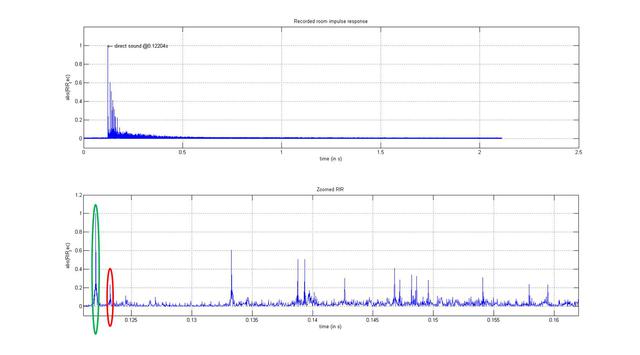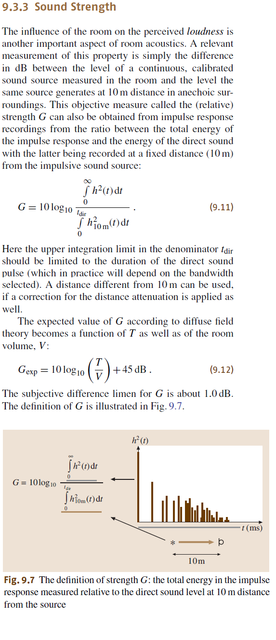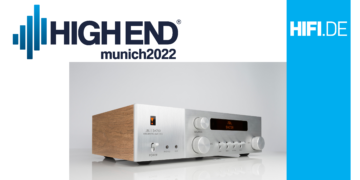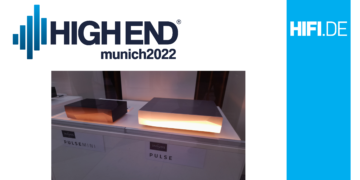| HIFI-FORUM » Akustik » Akustik » Sound strength in Akustikmessungen | |
|
|
||||
Sound strength in Akustikmessungen+A -A |
||
| Autor |
| |
|
lovre
Neuling |
#1
erstellt: 10. Mai 2018, 06:47

|
|
|
Hi everyone, I interpret sound strength (G) as a measure of gain/boost that room gives to the sound, and to calculate it, ratio between room impulse response (RIR) and direct sound are only two things that are needed. Direct sound can be extracted easily from RIR and so record of source in anechoic room is unnecessary. Also if someone wants to measure G using another stimulus (e.g. sine sweep, wavelets or something else) room response will be RIR convolved with this stimulus. In signal processing theory, impulse response is all that is needed to know exactly how some linear time invariant (LTI) system will behave and it would be very practical to observe room in this way. So, what am I missing?  Why do we need calibrated source that is recorded in anechoic surroundings on 10m distance to calculate G? Why do we need calibrated source that is recorded in anechoic surroundings on 10m distance to calculate G?Thanks! Lovre p.s. feel free to answer in German, I understand it quite well 
|
||
|
quecksel
Inventar |
#2
erstellt: 10. Mai 2018, 09:36

|
|
|
Hi,
Welche Methode stellst du dir da vor? Soweit ich weiß ist das eben nicht einfach... Ich bin mir aber nicht sicher ob ich dich richtig verstehe, kannst du nochmal genauer erklären was du mit G meinst? |
||
|
|
||
|
lovre
Neuling |
#3
erstellt: 10. Mai 2018, 11:45

|
|
|
Hi quecksel, For example, I have somehow recorded RIR and I have it in on my computer. If RIR_rec is name of variable in which I load recorded RIR than finding direct sound is straight forward. Here is simplified code of how it can be done in Matlab/Octave: directSound_value = max(abs(RIR_rec)); % here we find what is maximal value in recorded RIR (that is direct sound) directSound_position = find(abs(RIR_rec)==directSound_value); % here we find time of impact of direct sound (that is position in recorded RIR) And now when we know time of impact of direct sound we can extract it on different ways, but in ideal case when impulse is very short, it is enough to take several samples before and after the time of impact. What I mean with sound strength (G) is acoustic parameter that is defined by ISO standard and it is well described in Springer Handbook of Acoustics. It is also nice explained on this page: [/url]  http://www.ecophon.c...s/Auditory-strength/ http://www.ecophon.c...s/Auditory-strength/quecksel thank you for so quick answer and if something is still unclear, just say and I will try to clarify it better.. Mit freundlichen Grüßen |
||
|
ropf
Stammgast |
#4
erstellt: 10. Mai 2018, 12:15

|
|
|
The separation of direct and reflected sound is possible only if the wavelenght is small compared to the room dimensions and to the distances to the boundaries. So it does not work for the bass range. Impact of sound is a bit more than a peak value in a impulse respose, yout have to integrate it over the time. [Beitrag von ropf am 10. Mai 2018, 12:16 bearbeitet] |
||
|
lovre
Neuling |
#5
erstellt: 10. Mai 2018, 13:37

|
|
|
Hi ropf and thanks for your answer! As you can see on attached image, I can separate direct sound from first reflection quite easy. Now if pulse width was longer than time interval between direct sound (green) and first reflection (red) it would make things little bit complicated but this is not the case. I don't understand why do you think that wavelength and room dimensions are of interest here. Wavelength and room dimensions are important if you analyze impact of room modes.
I also don't understand what do you mean here by impact of sound. If I want to calculate reverberation time than one method is using reverse integration of RIR over time (so called Schroeder integration method). Did you mean that?  |
||
|
ropf
Stammgast |
#6
erstellt: 10. Mai 2018, 15:18

|
|
|
Look at a anechoic impulse respose of a loud speaker only - it usually lasts some ten ms - given by the lower bandwith limit. Even if the level of the later parts is small - the integral over the time (the acoutstic energy) is not. |
||
|
lovre
Neuling |
#7
erstellt: 10. Mai 2018, 16:34

|
|
|
Hi ropf and thanks again for your answer! I think I understand now what you are saying. We need to record loudspeaker (calibrated source) in anechoic room in order to get impulse together with all of its source imperfections (e.g. ringing of loudspeaker). But in that case room response will be convolution of RIR and impulse response of a loudspeaker, meaning that if we use some source (balloon or dummy pistol), that has no ringing or it is short, we could calculate G directly from RIR. Is this correct? |
||
|
quecksel
Inventar |
#8
erstellt: 10. Mai 2018, 21:22

|
|
|
Not really, given that the reflections are also highly dependent on the directivity of the measured object. A dummy pistol will radiate pretty evenly in most directions, a large full range speaker definitely won't. |
||
|
ropf
Stammgast |
#9
erstellt: 11. Mai 2018, 10:33

|
|
Basicly yes - you just replace a calibrated sound source by a perfect one. :-) Exactly yout get the transfer function of the room between two specific points. It varies heavily with frequency and with position of the source and the micro. You can estimate the perceived sound level by a flattend version of the transfer fuction wich is much less sensitive to spatial variations - but again, this works only in the range above the Schröder frequency. For the bass range in normal living room dimensions you need a modal analysis. [Beitrag von ropf am 11. Mai 2018, 10:35 bearbeitet] |
||
|
lovre
Neuling |
#10
erstellt: 11. Mai 2018, 16:14

|
|
This is both true, final value of G depends on positions in room where measurement is made and on source directivity pattern, but this is also true for all other acoustic parameters (EDT, T30, C50...) and still there is only for G explicit requirement for calibrated source recorded in anechoic room. Why is that? And ropf if I understood you correctly, there is no mathematical/principal reason why G can't be calculated directly from ideal RIR? |
||
|
ropf
Stammgast |
#11
erstellt: 16. Mai 2018, 09:29

|
|
|
EDT, T30 ... are decay parameters of the room independent of a specific source and its position. The claculation of sound strength is based on the basic asumption all the reflections come uncorrelated in a pure statistical way. This may be true (more or less) for large rooms as concert halls. In normal living room dimensions this basic assumption fails. Have a look in Floyd E. Tooles "Sound Reproduction: Loudspeakers and Rooms" |
||
|
lovre
Neuling |
#12
erstellt: 16. Mai 2018, 14:32

|
|
|
Hi ropf and thanks for staying in discussion! I think they do depend on both factors and here is why. 1) Different source radiation patterns excite room in a different way and that can lead to different decay curves. Take extreme example of source that radiates only in one direction, straight forward, and room walls (front and back) are orthogonal to it. Taking that walls don't diffuse incident sound, there will be no lateral reflections and no reflections form floor and ceiling, but only from walls in front and behind the source. This decay curves will be different from decay curves excited with omnidirectional source. 2) Second point, room acoustics is not the same for person on stage, in the first or in the last row. Sometimes in halls additional reflectors are installed to support mainly listeners in last rows or under the balconies. And regarding prediction of parameter G, there are several equations I came across but in ISO standard it is defined how to measure room response and calculate G from that measurement. In attached image there is snapshot from Springers Handbook of Acoustics regarding G parameter with two equations 9.11 and 9.12. If you use 9.12 than some assumptions are implied and what you get is expected G value, but if you really measure room response and use equations 9.11, than no assumptions are implied and you get true value of G (not expectation). My question remains, if we use dummy pistol for decay curves calculation, why can't we use it for sound strength calculation? |
||
|
ropf
Stammgast |
#13
erstellt: 16. Mai 2018, 15:41

|
|
|
Where is the image? |
||
|
lovre
Neuling |
#14
erstellt: 16. Mai 2018, 18:45

|
|
|
ropf
Stammgast |
#15
erstellt: 19. Mai 2018, 09:14

|
|
|
For 9.11 the denominator part has to be known. If you simply cut off a significat part of the ringing tail then you get wrong numbers. So what is significant? For the simplest case of a 1st order rolloff the enery below the axis has to be the same as in the peak to make the net result zero - it has a much lower level then the peak but is spreaded over long time. For 2nd (or higher) order rolloff as in loudspeakers there is even more energy in the tail and it lasts even longer. So the only way (if you dont have the anechoic impulse response) is making the tail short enough by making the lower frequency limit high enough - so low frequencys are simply not accounted. This may mattter or not - the formula negletes frequency dependent effects, directivity effects, psycoacoustic effects, modal effects anyway. 9.12 is a rule of thumb for 9.11 - valid only in a completly diffuse sound field - implying large rooms, long distances to the sound source, relatively high reverberation time, homogene absorbing properties of room boundarys ... You can do such a calculation for normal living room dimensions too, off course. But the numbers you get will be compleytly overhelmed by the negleted effects, especially modal effects in the bass range. |
||
| ||
|
|
||||
| Das könnte Dich auch interessieren: |
|
Software fuer Akustikmessungen MLuding am 15.10.2004 – Letzte Antwort am 23.02.2009 – 16 Beiträge |
|
Schlechter Sound in neuer Wohnung lawson am 18.02.2016 – Letzte Antwort am 01.03.2016 – 4 Beiträge |
|
Sound Optimierung abso am 16.02.2024 – Letzte Antwort am 17.02.2024 – 11 Beiträge |
|
Den Sound greifbar machen. jumber1 am 06.03.2008 – Letzte Antwort am 08.03.2008 – 3 Beiträge |
|
DBA für Stereo Sound fred76 am 01.11.2005 – Letzte Antwort am 16.12.2005 – 9 Beiträge |
|
§D-Sound in diesem Raum sinnvoll? Heimerdinger am 27.12.2022 – Letzte Antwort am 28.12.2022 – 5 Beiträge |
|
Besseren Sound durch zwei Subwoofer benvader0815 am 29.09.2010 – Letzte Antwort am 13.10.2012 – 19 Beiträge |
|
Kurze Verständnissfrage Hansomatik am 27.07.2011 – Letzte Antwort am 31.07.2011 – 18 Beiträge |
|
Mysteriöses sound poblem foxXx am 20.04.2005 – Letzte Antwort am 25.04.2005 – 9 Beiträge |
|
Sound uffn Dachboden Shawty20 am 06.11.2008 – Letzte Antwort am 07.11.2008 – 2 Beiträge |
Foren Archiv
2018
Anzeige
Produkte in diesem Thread

Aktuelle Aktion
Top 10 Threads in Akustik der letzten 7 Tage

- Hochfrequenztöne nachweisen
- Hilfe gesucht Brummton aus Nachbarwohnung zu ermitteln
- Schalldämmung gegen niederfrequentes Brummen // Infraschall // LKW-Motoren // Hilfe!
- Schalldämmung, Rigips oder Spanplatten?
- Hilft Basotec direkt hinter den LS?
- Wieviel Nachhall ist sinnvoll ?
- Low-Budget Deckensegel
- dB-Messung Lärm Poolumpe Aussenbereich
- Schallschutz im Reihenhaus
- DIY Akustikbild - Welchen Akustikstoff? Wo bestellen? Wo bedrucken lassen?
Top 10 Threads in Akustik der letzten 50 Tage

- Hochfrequenztöne nachweisen
- Hilfe gesucht Brummton aus Nachbarwohnung zu ermitteln
- Schalldämmung gegen niederfrequentes Brummen // Infraschall // LKW-Motoren // Hilfe!
- Schalldämmung, Rigips oder Spanplatten?
- Hilft Basotec direkt hinter den LS?
- Wieviel Nachhall ist sinnvoll ?
- Low-Budget Deckensegel
- dB-Messung Lärm Poolumpe Aussenbereich
- Schallschutz im Reihenhaus
- DIY Akustikbild - Welchen Akustikstoff? Wo bestellen? Wo bedrucken lassen?
Top 10 Suchanfragen

Forumsstatistik

- Registrierte Mitglieder928.520 ( Heute: 1 )
- Neuestes Mitgliedclimber74
- Gesamtzahl an Themen1.558.369
- Gesamtzahl an Beiträgen21.700.924












